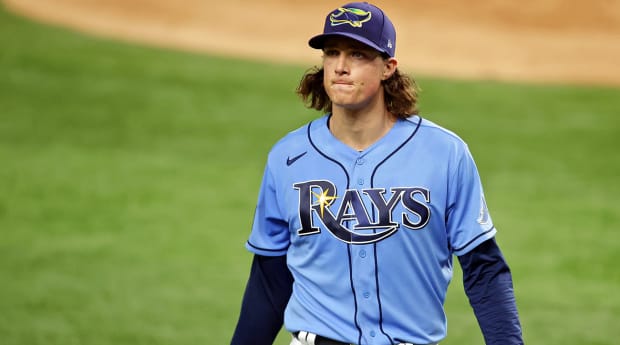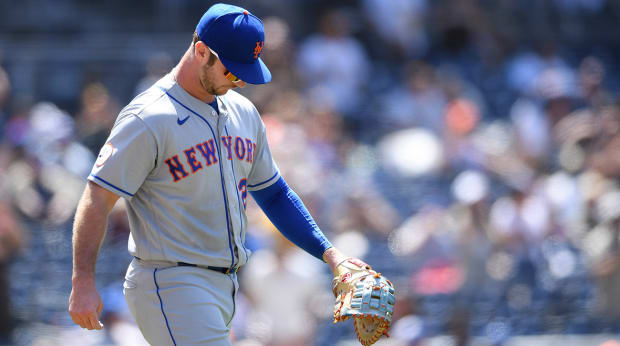The league needed to start enforcing its rules against pitch doctoring, but the results could be disruptive across the game.

Welcome to The Opener, where every weekday morning you’ll get a fresh, topical column to start your day from one of SI.com’s MLB writers.
MLB’s press release announcing its decision to crack down on foreign substances was nine paragraphs long, stuffed with quotes from the commissioner’s office, information on how umpires would check pitchers and details on the appropriate punishments. Yet it missed some big questions. Such as: Why did the league feel the need to act now, midseason, after failing to do anything for years? What answer does it have for players who suddenly have real concerns about safety? And what happens if the new solution ends up as sticky as the problem?
There is a line of thinking that goes something like this: Players have broken the rules by doctoring baseballs for years, so the league has every right to crack down whenever it likes, including in the middle of a season. That’s true. But it ignores some crucial context. MLB continuously avoided this while it allowed this problem to fester. There’s a long history of pitchers using foreign substances to help with their grip, and as the league declined to enforce the rules in all but the most obvious instances, a significant proportion of pitchers in the last few years have begun using something—even as the substances have grown more advanced and their effects have become more pronounced. This means that trying to add a layer of strict enforcement now affects just about everyone, rather than only a small group of pitchers, and the results very well might be disruptive across the game.
So it’s perfectly reasonable to be frustrated with pitchers who flouted the rules and pushed the sport to its limits here. But hold some frustration for the league that stood by and watched it happen without doing anything before trying to crack down all at once.
Consider, too, that this announcement comes at a time when trust between players and management is already low. The decision to suddenly introduce new guidelines midseason, with an official notice period of just a week, serves only to frustrate players and erode that trust further. (Umpires have been instructed to begin ejecting pitchers who are suspected of using foreign substances on June 21. Those pitchers ejected will receive automatic 10-game suspensions.) And if the issue of frustration here seemed potentially theoretical, MLB had to wait only a few hours after sending out its press release to see what it would look like in action.
Rays ace Tyler Glasnow was diagnosed with a flexor tendon strain and a partial tear of his UCL on Tuesday after exiting his start early on Monday. In a press conference, he said that he felt he’d developed the injury after adjusting his grip as news of the potential crackdown leaked—going without his usual mixture of sunscreen and rosin and changing both his fastball and his curve as a result.
His issue, he said, was not so much in the enforcement itself. It was in the sudden announcement midseason.
"Do it in the offseason. Give us a chance to adjust to it,” Glasnow said. "But I just threw 80 innings, then you tell me I can’t use anything in the middle of the year. I have to change everything I’ve been doing the entire season. I’m telling you I truly believe that’s why I got hurt."
It can be easy to look at a statement like that and think, well, don’t rely on illegal substances in the first place, and you won’t have to risk injury by adjusting once you have to try going without. But reports indicate that most pitchers out there are using one kind of substance or another. The new enforcement does not take out just the most egregious offenders—like, say, those who have turned in recent years to Spider Tack, the glue for competitive strongmen that can dramatically increase spin rate. It addresses everyone—which might end up causing a mess when there are pitchers who have always used something like sunscreen and rosin to get a better grip on the ball. Does this mean that there’s automatically going to be a notable spike in pitcher injuries? No. Does it mean that pitchers have good reason to feel unsettled about suddenly needing to change their approach? Yes. And it’s not good for MLB, either, to have one of its best young starters publicly calling out the league for a health issue that will likely sideline him for months.
There’s also the hitters’ perspective on safety to consider here. It’s naturally in the hitter’s best interests for the pitcher to feel like he has a solid grip on the ball—something that substances have long been used to assist, particularly since every baseball can feel different, depending on the weather and how it was treated with rubbing mud before the game. Take that away, particularly in this era of flamethrowers, and it doesn’t seem unreasonable to wonder whether we'll see even more hit-by-pitches than we are now. MLB has tried to dismiss this idea—it said in its press release that it had not found a link between substances and HBPs. But it didn’t offer much in the way of specific evidence for that claim, and, with the low level of trust here, it seems that some hitters believe otherwise.

“For me, whether they are using pine tar, rosin, sunscreen or Bullfrog or whatever they want to use to control the ball, let them use it, because for me, I go into the box and see guys throwing harder every day,” Mets first baseman Pete Alonso said last week. “And I don’t want 99 mph slipping out of someone’s hand because they didn’t have enough feel for it.”
Again, it can be easy to look at that and think, well, guys shouldn’t be throwing triple digits if they can’t feel sure about where it’s going. But that can require a change in pitching style. It can require time. And MLB had that time—to watch this problem develop, to potentially find a universally acceptable substance that could be used as a grip agent, to figure out a way forward that was more acceptable to players—and it let it fly on by. Now, as it tries to do as much as it can all at once, it stares down a risk of injuries, player resentment and mid-season chaos.
“Sunscreen and rosin is apparently the same as Spider Tack,” Glasnow said Tuesday when describing the takeaway from MLB’s new guidance. “All right, I guess I’ll adapt and learn. And the only thing I learned was that it hurts to throw a ball in the middle of the season from having something to not having something.”
It seems clear that some kind of new enforcement was needed here—the problem had simply gotten too big. But MLB had space to figure something out. It did not need to throw new guidelines at the wall just to see what sticks.
More MLB Coverage:
• Sticky Cleanup: What Pitch-Doctoring Enforcement Means for MLB
• He Made Sticky Stuff for MLB Pitchers for 15 Years. Now He's Speaking Out.
• MLB's Pitch Doctoring Scandal Goes Beyond Individual Offenders
• 'This Should Be the Biggest Scandal in Sports'